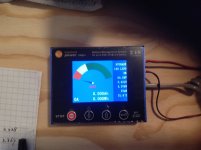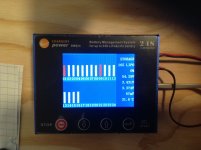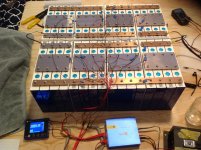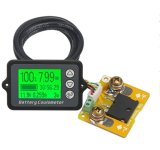Hi,
I am constructing a 16s 48V lifepo battery bank for powering a 10kW electromotor on my sailboat. The bank is currently in a test setup at home, please see attached pictures. Each of the 16 's' consists of 4 cells in parallel, so 64 individual cells total. I am (currently) charging with a 48V charger for lead acid golf chart batteries, charging voltage up to 58V, 15A max, which should be a trickle charge for the 400Ah bank.
I am using a Chargery BMS24T as controller/balancer. I am fairly new to lithium batteries and everything around them, and do not want to risk burning down my house (or worse, my boat). So I could use some advice.
0) The BMS24 seems to support LiFe and LiPo. I have the impression that it autodetects, because I am unable to select the type, and it starts up with LiPo when connected to my batteries. Neither of these two is LiFePo, but the selection should only affect initial configuration values which I will be able to change anyway, and for selecting a charge profile that is used for displaying SOC. Correct?
1) The meager data sheet for my batteries lists a maximum charging voltage of 3.65V, but I am unable to set the overcharge P voltage of the controller lower than 3.9V. Reading information on LiFePo charging curves on the internet I have the impression that this is not a problem, and that I can still safely charge up to 4.2V per cell. That would mean that the datasheet is a bit overprotective. Am I correct in assuming this?
2) Although I have the battery more than 50% charged already, the BMS insists that the SOC is still 0%. As a result, the discharge relay is kept open, although the charging relay works fine. The BMS also refuses to be powered by the batteries themselves: power selector to Bat keeps the BMS dead, so I currently have the selector to Ext and am powering it with an external power supply. However, this will be impractical when the bank is rigged on my boat. This inability to power from the battery could be related to the fact that the SOC thinks that the battery is empty. What am I doing wrong here?
Thanks for any input,
Juul
I am constructing a 16s 48V lifepo battery bank for powering a 10kW electromotor on my sailboat. The bank is currently in a test setup at home, please see attached pictures. Each of the 16 's' consists of 4 cells in parallel, so 64 individual cells total. I am (currently) charging with a 48V charger for lead acid golf chart batteries, charging voltage up to 58V, 15A max, which should be a trickle charge for the 400Ah bank.
I am using a Chargery BMS24T as controller/balancer. I am fairly new to lithium batteries and everything around them, and do not want to risk burning down my house (or worse, my boat). So I could use some advice.
0) The BMS24 seems to support LiFe and LiPo. I have the impression that it autodetects, because I am unable to select the type, and it starts up with LiPo when connected to my batteries. Neither of these two is LiFePo, but the selection should only affect initial configuration values which I will be able to change anyway, and for selecting a charge profile that is used for displaying SOC. Correct?
1) The meager data sheet for my batteries lists a maximum charging voltage of 3.65V, but I am unable to set the overcharge P voltage of the controller lower than 3.9V. Reading information on LiFePo charging curves on the internet I have the impression that this is not a problem, and that I can still safely charge up to 4.2V per cell. That would mean that the datasheet is a bit overprotective. Am I correct in assuming this?
2) Although I have the battery more than 50% charged already, the BMS insists that the SOC is still 0%. As a result, the discharge relay is kept open, although the charging relay works fine. The BMS also refuses to be powered by the batteries themselves: power selector to Bat keeps the BMS dead, so I currently have the selector to Ext and am powering it with an external power supply. However, this will be impractical when the bank is rigged on my boat. This inability to power from the battery could be related to the fact that the SOC thinks that the battery is empty. What am I doing wrong here?
Thanks for any input,
Juul





